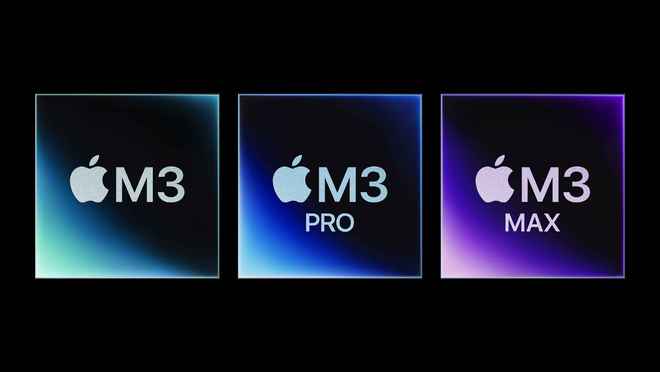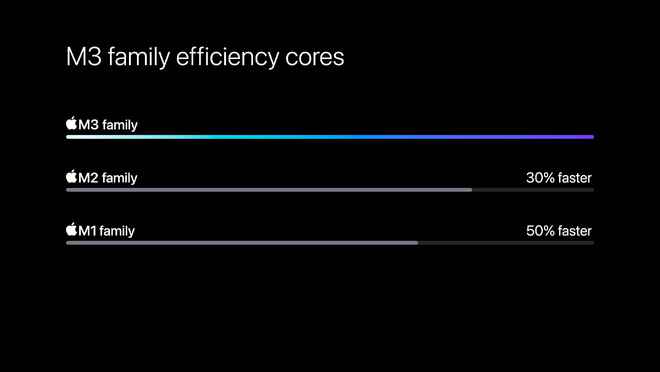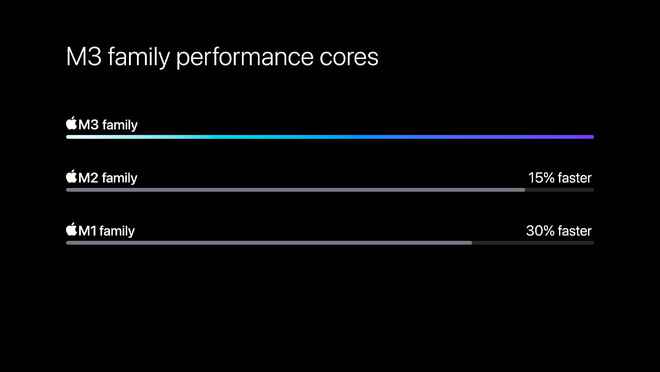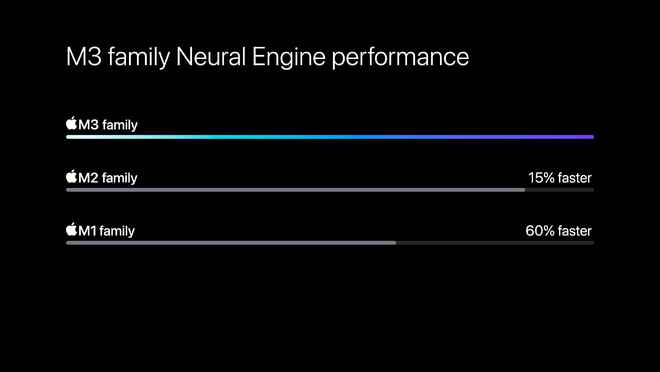M3/M3Pro/M3Max chip release: adding hardware light tracing function
Apple announced its M3, M3Pro, and M3Max chips today. These three new chips adopt a series of breakthrough technologies, bringing unimaginable performance improvements to the Mac and unlocking numerous new features
Apple announced its M3, M3Pro, and M3Max chips today. These three new chips adopt a series of breakthrough technologies, bringing unimaginable performance improvements to the Mac and unlocking numerous new features. This is the first batch of personal computer chips manufactured using industry-leading 3-nanometer technology, which can package more transistors in smaller chip spaces, achieving dual improvements in speed and energy efficiency. The M3, M3Pro, and M3Max chips showcase Apple's significant progress in the Mac chip field since the initial release of the M1 series chips.

The M3 series chips are equipped with a new generation of graphics processors, achieving the largest leap in graphics processor architecture in Apple chip history. This graphics processor not only has faster speed and higher energy efficiency, but also introduces a new technology - dynamic caching, and brings new rendering features such as hardware accelerated ray tracing and mesh shading for the first time landing on a Mac. Compared to the M1 series chips, the rendering speed can reach up to 2.5 times faster. The high-performance and energy-efficient cores carried by the central processing unit are 30% and 50% faster than the corresponding cores in the M1 series, respectively, and the neural network engine is also 60% faster than the M1 series chips. In addition, the new media processing engine now supports AV1 decoding, providing a dual improvement in energy efficiency and quality for video experiences from streaming services. The M3 series of chips continues to significantly advance the innovation pace of Apple chips, bringing numerous improvements and new features to the newly launched MacBookPro and iMac.

Apple chips have completely redefined the Mac experience. All aspects of its architecture design are aimed at achieving dual improvements in performance and energy efficiency, "said John Srouji, Apple's Senior Vice President of Hardware Technology, The M3, M3Pro, and M3Max chips adopt a 3-nanometer technology, equipped with a next-generation graphics processor architecture, a high-performance central processing unit, a faster neural network engine, and support for larger unified memory, creating an extremely advanced lineup of personal computer chips
The new graphics processor introduces dynamic caching, hardware accelerated ray tracing, and mesh coloring functions
The new generation of graphics processors in the M3 series of chips has achieved the largest leap in graphics processor architecture in Apple chip history. Unlike traditional graphics processors, it has dynamic caching capabilities, allowing for real-time allocation of local memory usage in hardware. With the support of dynamic caching function, each task accurately meets the required memory consumption. This industry-leading technology is transparent to developers and provides the cornerstone for building a new graphics processor architecture. It significantly improves the average utilization of graphics processors, thereby significantly improving the performance of more demanding professional apps and games.
With the support of the M3 series of chips, the hardware accelerated ray tracing function has landed on the Mac for the first time. Ray tracing technology can simulate the performance of light in a scene, helping apps create lifelike and realistic images. With this feature and the addition of a new graphics processor architecture, the professional app can run up to 2.5 times faster than the M1 series chips. Game developers can use ray tracing technology to create more refined and accurate shadows and reflections, thereby creating a highly immersive environment. In addition, the new graphics processor also brings hardware accelerated grid coloring function to the Mac, achieving dual improvements in graphics processing power and energy efficiency. It can also support games and apps with high graphics processing requirements to present more complex visual effects. This groundbreaking graphics processor architecture provides support for all the optimization improvements mentioned above, while continuing the high energy efficiency characteristics of Apple chips. In fact, the M3 graphics processor can achieve performance comparable to M1 with half the power consumption, and can achieve up to 65% performance improvement at peak power consumption.
Faster and more energy-efficient central processing unit


The new generation central processing unit (CPU) equipped with M3, M3Pro, and M3Max chips has optimized and improved the high-performance and energy-efficient cores in the architecture. Due to the high performance core being up to 30% faster than the M1 series chips, the task of compiling and testing millions of lines of code using Xcode is further accelerated, and musicians can also run hundreds of audio tracks, plugins, and virtual instruments in LogicPro. Compared to the energy efficiency core of the M1 chip, the energy efficiency core in M3 can increase speed by up to 50%, providing the most durable battery life for the system while further accelerating daily tasks. The central processing unit composed of these cores can provide multithreading performance comparable to M1 with half the power consumption, while achieving a performance improvement of up to 35% at peak power consumption.
Unparalleled unified memory architecture with up to 128GB of capacity
All chips in the M3 family are equipped with Apple's iconic unified memory architecture. This brings high bandwidth, low latency, and unparalleled high energy efficiency. A custom packaged unified memory pool means that all technologies carried on the chip can access the same data without the need to replicate it to multiple memory pools, which can further improve performance and energy efficiency while reducing the memory capacity required by the system to handle most tasks. In addition, the memory capacity supported by the M3 chip can reach up to 128GB, making it possible for workflows that could not have been processed on laptops in the past. For example, AI developers can now run larger Transformer models with billions of parameters.
AI and video customization engine

The M3, M3Pro, and M3Max chips also introduce enhanced neural network engines to accelerate powerful machine learning (ML) models. Compared to the M1 series chips, the new neural network engine brings a speed increase of up to 60%, further accelerating AI/ML workflows while also retaining data on the device to protect user privacy. The speed of powerful AI image processing tools such as noise reduction and super-resolution in Topaz has further accelerated. The scene editing and detection function in Adobe Premiere and the intelligent matching function in FinalCutPro have also been accelerated.
In addition, all three chips in the M3 series are equipped with more advanced media processing engines, providing hardware acceleration for the most commonly used video encoding, including H.264, HEVC, ProRes, and ProResRAW. The media processing engine also supports AV1 decoding for the first time, enabling streaming media playback with higher energy efficiency and achieving more durable battery life.
M3 chip: bringing extraordinary performance to popular systems
The M3 chip is equipped with 25 billion transistors -5 billion more than M2. This chip is also equipped with a 10 core graphics processor using a new generation architecture, delivering graphics processing performance up to 65% faster than the M1, making the lighting, shadows, and reflection effects in the game lifelike. The M3 chip is equipped with an 8-core central processing unit, which includes 4 performance cores and 4 energy efficiency cores. Compared to the M1, it can achieve up to 35% improvement in central processing unit performance. It also supports up to 24GB of unified memory.
M3Pro chip: designed for users pursuing higher performance
The M3Pro chip is equipped with 37 billion transistors and an 18 core graphics processor, which can unleash tremendous performance when running heavier graphics processing tasks. Compared to M1Pro, this graphics processor provides a speed increase of up to 40%. The support for unified memory has been increased to up to 36GB, ensuring that users can use MacBookPro to handle larger projects anytime, anywhere. The 12 core CPU design consists of 6 performance cores and 6 energy efficiency cores, which can achieve up to 30% single threaded performance improvement compared to M1Pro. On the new MacBookPro equipped with M3Pro chips, using Adobe Photoshop to splice and edit large panoramic photos has become more efficient and smooth.
M3Max chip: A significant leap in performance, effortlessly handling the most demanding professional workloads
The number of transistors in the M3Max chip has increased to 92 billion, reaching a new high in professional performance. The 40 core graphics processor is up to 50% faster than the M1Max and supports up to 128GB of unified memory, making it easy for AI developers to process large-scale Transformer models with billions of parameters. The 16 core CPU is equipped with 12 performance cores and 4 energy efficiency cores, achieving amazing performance and a speed increase of up to 80% compared to the M1Max. In addition, with the support of two ProRes engines, even when performing video post processing on content with the highest resolution, whether users are using DaVinciResolve, Adobe PremierePro, or FinalCutPro, M3Max can achieve both speed and smoothness. Professionals need a professional laptop that can fully unleash the highest performance of MacBookPro and have industry-leading battery life, and the M3Max chip is precisely designed for them.
More environmentally friendly
Thanks to the impressive energy efficiency performance of the M3, M3Pro, and M3Max chips, the newly launched MacBookPro and iMac meet Apple's strict environmental standards, with the new MacBookPro becoming the most durable model among Macs with a battery life of up to 22 hours. Therefore, the required charging time and energy consumption throughout the entire lifecycle of the product have been reduced.
Apple has achieved carbon neutrality in global company operations and plans to achieve net zero climate impact on all company businesses by 2030, including the entire manufacturing supply chain and all product lifecycle. This means that every chip carried in every Mac, from design to manufacturing, will achieve carbon neutrality.
Tag: M3 M3Pro M3Max chip release adding hardware light tracing
Disclaimer: The content of this article is sourced from the internet. The copyright of the text, images, and other materials belongs to the original author. The platform reprints the materials for the purpose of conveying more information. The content of the article is for reference and learning only, and should not be used for commercial purposes. If it infringes on your legitimate rights and interests, please contact us promptly and we will handle it as soon as possible! We respect copyright and are committed to protecting it. Thank you for sharing.


